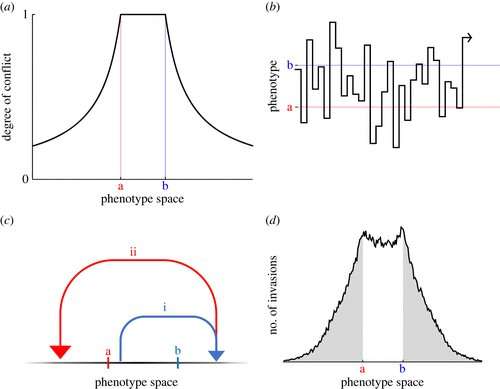Evolutionary dynamics in one dimension and conflict-driven maladaptation. (a) The degree of conflict is maximal between the two optima and declines monotonically outwith this interval. (b) Conflict drives never-ending fluctuation in the phenotype both within and outwith the interval between the two optima (shown here is a single numerical simulation run for 30 invasion events). (c) The phenotype can escape the interval between the optima by leap-frogging between the far sides of each optimum, to become arbitrarily distant from either. (d) At equilibrium, a probability density emerges in which the phenotype is at least as likely to be found outwith the interval between the two optima as within it (shown here is a single numerical simulation run for 1.5 × 105 invasion events). For the purpose of illustration, (a,b,d) assume that all mutations are equally likely and (b,d) make use of Fisher's assumption that beneficial alleles are certain to proceed to fixation. Credit: Proceedings of the Royal Society B: Biological Sciences (2023). DOI: 10.1098/rspb.2022.2423
The divergent goals of two opponents—whether they are individual people or entire nations—can be thought of as two points in a multi-dimensional space of possibilities, and the ensuing battle of wills can be described in terms of a ball bouncing around in this same space. When one party gains temporary control of the ball, they move it closer to where they want to to be, but their opponent is then liable to seize control and move the ball in the opposite direction.
A new paper published in Proceedings of the Royal Society B: Biological Sciences focuses on conflicts that are of interest to evolutionary biologists—including those occurring between genes, between individuals, between the sexes, and between the generations.
The geometric approach reveals that not only are these conflicts liable to continue indefinitely through evolutionary time, but that they are also able to spill out from the initial battleground and cause extensive collateral damage in areas where there is no actual disagreement. The damage is particularly devastating to complex organisms and social structures, and so conflict places an important barrier to the evolution of complexity.
The geometric analysis finds that such collateral damage is greatly reduced if organisms and their societies embody the principle of modular design, which constrains the bouncing ball to move only in certain directions at any given time.
This suggests that modularity is a crucial—and previously unappreciated—enabler of complex adaptation and transformative changes in social organization, from the evolution of multicellular life to the emergence of superorganismal insect societies.
More information: Petri Rautiala et al, The geometry of evolutionary conflict, Proceedings of the Royal Society B: Biological Sciences (2023). DOI: 10.1098/rspb.2022.2423
Journal information: Proceedings of the Royal Society B
Provided by University of St Andrews
























